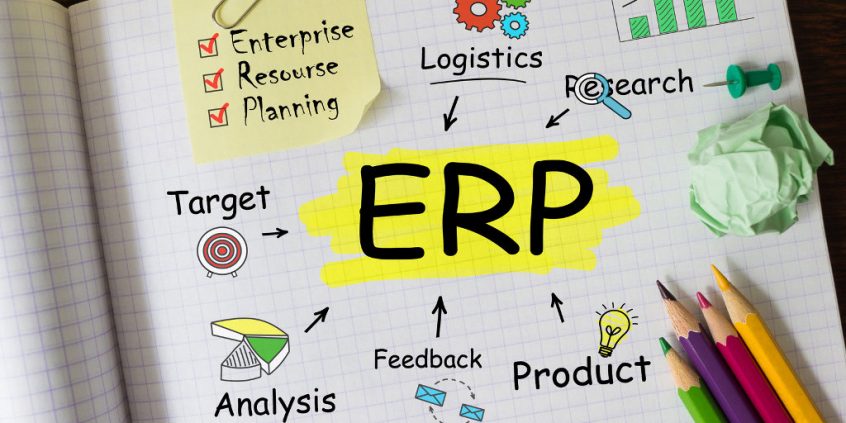Share this Post
The continuing growth of online commerce as a driving force in modern business practices is fueling the need for enterprises to rely on connected systems, networks, and software to conduct their affairs. And there’s a need for increased efficiency and the streamlining of business operations in an environment where organisations no longer have their work forces confined to a particular location.
With project timetables, working practices, and working hours becoming increasingly flexible and informal, businesses require an integrated set of tools to ensure effective collaboration, communications, and product or service delivery. Automation and integrated software platforms have already found application in areas such as Sales, Marketing, and Customer Relationship Management (CRM). Another field where integrated and often complex systems exist is in ERP.
What’s ERP?
Enterprise Resource Planning or ERP is the process by which an enterprise integrates and manages the important elements of its business. These elements may include areas as diverse as planning, purchasing, Research and Development (R & D), Human Resources (HR), operations, finance, inventory, sales, and marketing – and making sure that they all work together in tandem can be a daunting task.
Organizing and integrating all these aspects of an enterprise is the work of an ERP management information system – a business software platform designed specifically for that purpose. The ability to scale and customize an ERP system is crucial to its effective operation, and putting one to work can be a challenge in itself – not least because of the organisational changes and shifts in mind-set that may be required at enterprise level.
Putting the following six recommendations into practice can help ensure a successful ERP implementation.
1. Establishing Shared Goals and Objectives
Sure, your enterprise has resources. But what do you intend to do with them? And what do you hope to achieve by so doing?
The answers to questions like these need to be established at the outset of any ERP project. Your operational and business objectives need to be identified, together with a clear idea of how each objective may be achieved using the resources and talent you have available. An ERP system is intended to assist you in meeting your objectives in the most efficient manner – so having a clear set of defined goals is essential to designing or choosing the software.
To ensure that the system is acceptable to users throughout your organisation, input in establishing these goals should be invited from stakeholders at all levels. This extends to your ERP software vendor, or to your development team if you’re commissioning a custom-tailored ERP solution.
2. Putting A Plan Together
Intelligent and careful planning is required at all stages of a successful implementation. This starts with identifying the business and operational needs, functional requirements, and levels of usability that your ERP software needs to satisfy.
Thorough assessments should be conducted to establish all of these requirements – again pulling in input from all levels of your enterprise.
A project management team should be set up, with clearly defined leadership, designated persons responsible for specific functions, mechanisms for assessment and reporting, and well-established lines of communication between its members.
Your management team may not be able to think of every possibility and plan for every eventuality before the system goes online, but careful planning should assist you in creating the blueprint for an optimal design, and in identifying potential issues that may affect the deployment.
3. Preparing for the Unexpected
Of course, life isn’t perfect (or simple) – and even with the best planning in the world, unanticipated events will occur. But part of the planning process is to allow for these, in the form of risks, constraints, and opportunities. You’ll need to take a detailed view of your existing operations, your hopes for the new ERP installation, and the possible complications which may arise. These will form the basis of your risk assessment.
The assessment should incorporate a table or matrix of possible outcomes and contributing factors to the project which may present as negative or positive. For the negative ones (risks and constraints), you’ll need to develop strategies for containing, overcoming, or reducing their effects. Opportunities or positive outcomes and influences should be maximized wherever possible.
4. Testing, Testing, Testing
Since so many ERP deployments fail at the usability and configuration stages, it’s essential that comprehensive testing of the software platform be done at the development stage (for a custom-made or bespoke solution), prior to installation and roll-out of the system, and to iron out any wrinkles once the system is in place.
Testing of the software will enable you to:
It’s also essential to allow some time and budgetary allocations for training your workers and supervisors (including IT, security, and management) on the ins and outs of the new software.
5. Charting Progress Along the Way
To assist you in determining the success or otherwise of your ERP deployment and its effects on your business as a whole, it’s vital to monitor and report on the progress of your implementation as it proceeds from development or purchase through to installation, testing, user training, and performance in your day-to-day operations.
Choose measurable quantities that are relevant and specific to your particular industry, scope of operations, and user base.
6. Maintaining Channels of Communication
At all stages of the project (planning, development/purchase, testing, installation, implementation, operational use, etc.) it’s essential to maintain stable channels of communication. These will allow needs, issues, and operational matters to be discussed within your management team, and enable your users to give feedback on their experiences with the system, or to get help and technical support as required.
Your circumstances and the disposition of your workforce will determine the most appropriate methods of communication that you choose: email, instant messaging, telephone, video conferencing, etc.



